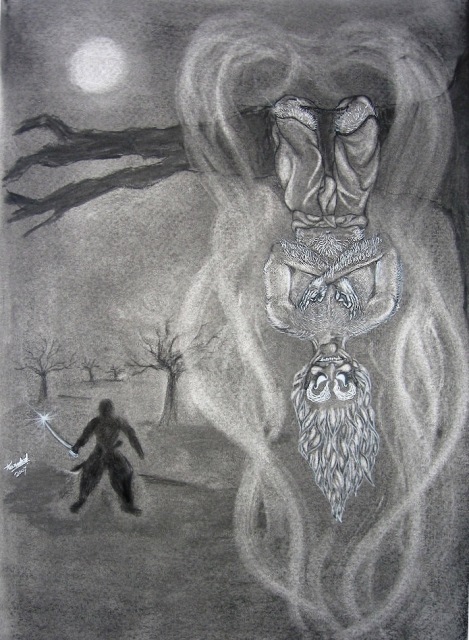|
Śivadāsa
┼Üivad─üsa was the author of one of the best-known versions of stories from the Vet─ülapa├▒─ćavin┼øati or "Vet─üla Tales"; a series of n─½ti-┼ø─üstras (tales of political ethics) involving the semi-legendary Indian king Vikram─üditya. The Author Nothing is known about him for certain. The name is probably a nom-de-plume. Based on what may be inferred from his writing, he was a very well-educated courtier whose audience consisted of young men in the lower nobility with plenty of leisure time and a fondness for amusing stories involving warriors and courtesans. He may also have been an orator/actor who developed his stories through performance and only later wrote them down. He is believed to have lived somewhere between the twelfth to fourteenth centuries AD. The Tales Though often attributed to Bhavabhuti, the true origin of these tales is lost in antiquity. They appear to have been part of a large corpus of Kath─ü (narrative tales) about Vikram─üditya that were first written dow ... [...More Info...] [...Related Items...] OR: [Wikipedia] [Google] [Baidu] |
Vetala Panchvimshati
''Vetala Panchavimshati'' ( sa, ÓżĄÓźćÓżżÓżŠÓż▓Óż¬Óż×ÓźŹÓżÜÓżĄÓż┐ÓżéÓżČÓżżÓż┐, IAST: ) or ''Betaal Pachisi'' ("''Twenty-five (tales) of Betaal''"), is a collection of tales and legends within a frame story, from India. It is also known as internationally Vikram-Betaal. It was originally written in Sanskrit. One of its oldest recensions is found in the 12th Book of the ''Kathasaritsagara'' ("Ocean of the Streams of Story"), a work in Sanskrit compiled in the 11th century by Somadeva, but based on yet older materials, now lost. This recension comprises in fact twenty-four tales, the frame narrative itself being the twenty-fifth. The two other major recensions in Sanskrit are those by ┼Üivad─üsa and Jambhaladatta. The Vetala stories are popular in India and have been translated into many Indian vernaculars. Several English translations exist, based on Sanskrit recensions and on Hindi, Tamil, Bengali and Marathi versions. Probably the best-known English version is that of Sir Richar ... [...More Info...] [...Related Items...] OR: [Wikipedia] [Google] [Baidu] |
Vikram─üditya
Vikramaditya (IAST: ') was a legendary king who has been featured in hundreds of traditional stories including those in ''Baital Pachisi'' and ''Singhasan Battisi''. Many describe him as ruler with his capital at Ujjain (Pataliputra or Pratishthana in a few stories). The term ''Vikramaditya'' is also used as a title by several Hindu monarchs. According to popular tradition, Vikramaditya began the Vikrama Samvat era in 57 BCE after defeating the Shakas, and those who believe that he is based on a historical figure place him around the first century BCE. However, this era is identified as "Vikrama Samvat" after the ninth century CE. "Vikramaditya" was a common title adopted by several Indian kings, and the Vikramaditya legends may be embellished accounts of different kings (particularly Chandragupta II). Nevertheless, many scriptures from the Shaka era mentions the mighty ruler. Early legends Malava king Rajbali Pandey, Kailash Chand Jain and others believe that Vikramadi ... [...More Info...] [...Related Items...] OR: [Wikipedia] [Google] [Baidu] |
Jain
Jainism ( ), also known as Jain Dharma, is an Indian religion. Jainism traces its spiritual ideas and history through the succession of twenty-four tirthankaras (supreme preachers of ''Dharma''), with the first in the current time cycle being Rishabhadeva, whom the tradition holds to have lived millions of years ago, the twenty-third ''tirthankara'' Parshvanatha, whom historians date to the 9th century BCE, and the twenty-fourth ''tirthankara'' Mahavira, around 600 BCE. Jainism is considered to be an eternal ''dharma'' with the ''tirthankaras'' guiding every time cycle of the cosmology. The three main pillars of Jainism are ''ahiß╣ās─ü'' (non-violence), ''anek─üntav─üda'' (non-absolutism), and '' aparigraha'' (asceticism). Jain monks, after positioning themselves in the sublime state of soul consciousness, take five main vows: ''ahiß╣ās─ü'' (non-violence), '' satya'' (truth), '' asteya'' (not stealing), ''brahmacharya'' (chastity), and '' aparigraha'' (non-possessiveness). Th ... [...More Info...] [...Related Items...] OR: [Wikipedia] [Google] [Baidu] |
Champu
Champu or Chapu-Kavya (Devanagari: ÓżÜÓż«ÓźŹÓż¬Óźé-ÓżĢÓżŠÓżĄÓźŹÓż») is a genre of literary composition in Indian literature. The word 'Champu' means a combination of poetry and prose. A ''champu-kavya'' consists of a mixture of prose (Gadya-Kavya) and poetry passages (Padya-Kavya), with verses interspersed among prose sections. We can see champu-kavya right from the Vedic period. Ithareya Brahmans Harishchandropakyana is the main example, that it is originated from Vedic period. Champu-kavya is seen in 2nd century AD, on rock inscription of Rudradaman, at Junagadh. It is also seen in Ramayana, Mahabharata, Puranas, and the other Mahakavyas and was a later development in the style of writing. Works in Champu style Kannada Adikavi Pampa, the ''Adikavi'', one of the greatest Kannada poets of all time and one among the ''ratnatrayaru'', pioneered this style when he wrote his classical works, ''Vikramarjuna Vijaya'' (Pampa Bharata) and '' Adipurana'' in it, around 940 CE, and w ... [...More Info...] [...Related Items...] OR: [Wikipedia] [Google] [Baidu] |
Genie
Jinn ( ar, , ') ŌĆō also romanized as djinn or anglicized as genies (with the broader meaning of spirit or demon, depending on sources) ŌĆō are invisible creatures in early pre-Islamic Arabian religious systems and later in Islamic mythology and theology. Like humans, they are accountable for their deeds, can be either believers (''Muslim'') or unbelievers (''kafir''); depending on whether they accept God's guidance. Since jinn are neither innately evil nor innately good, Islam acknowledged spirits from other religions and was able to adapt spirits from other religions during its expansion. Jinn are not a strictly Islamic concept; they may represent several pagan beliefs integrated into Islam. To assert a strict monotheism and the Islamic concept of ''Tauhid'', Islam denies all affinities between the jinn and God, thus placing the jinn parallel to humans, also subject to God's judgment and afterlife. The Quran condemns the pre-Islamic Arabian practise of worshipping the ... [...More Info...] [...Related Items...] OR: [Wikipedia] [Google] [Baidu] |
Vetala
A vetala ( sa, ÓżĄÓźćÓżżÓżŠÓż▓ ') or Betal is a Bhairava form of Shiva in Hindu mythology, usually defined as a knowledgeable (fortune telling) paranormal entity said to be dwelling at charnel grounds. The vetala is comparable to the vampires of Western mythology. Reanimated corpses are used as vehicles by the spirits for movement, the corpse no longer decays while it is inhabited by a ''vetala''. A vetala may possess and also leave a dead body at will. Description In Hindu folklore, the vetala is an evil spirit who haunts cemeteries and takes demonic possession of corpses. They make their displeasure known by troubling humans. They can drive people mad, kill children, and cause miscarriages, but also guard villages. They are hostile spirits of the dead trapped in the 'twilight zone' between life and afterlife. These creatures can be repelled by the chanting of mantras. One can free them from their ghostly existence by performing their funerary rites. Being unaffected by the laws ... [...More Info...] [...Related Items...] OR: [Wikipedia] [Google] [Baidu] |
Necromancer
Necromancy () is the practice of magic or black magic involving communication with the dead by summoning their spirits as apparitions or visions, or by resurrection for the purpose of divination; imparting the means to foretell future events; discovery of hidden knowledge; returning a person to life, or to use the dead as a weapon. Sometimes referred to as "death magic," the term is used in a more general sense to refer to black magic or witchcraft. The word ''necromancy'' is adapted from Late Latin : a loan word from the post-Classical Greek (), a compound of Ancient Greek (, or 'dead body') and (, or 'divination'). The Koine Greek compound form was first documented in the writings of Origen of Alexandria in the 3rd century AD. The Classical Greek term was (), from the episode of the ''Odyssey'' in which Odysseus visits the realm of the dead souls, and in Hellenistic Greek; in Latin, and ''necromancy'' in 17th-century English. Antiquity Early necromancy was related ... [...More Info...] [...Related Items...] OR: [Wikipedia] [Google] [Baidu] |
Murray Barnson Emeneau
Murray Barnson Emeneau (February 28, 1904 ŌĆō August 29, 2005) was the founder of the Department of Linguistics at the University of California, Berkeley. Early life and education Emeneau was born in Lunenburg, a fishing town on the east coast of Nova Scotia, Canada. Having distinguished himself in classical languages in high school, he obtained a four-year scholarship to Dalhousie University in Halifax to further his classical studies. On obtaining his B.A. degree from Dalhousie, Emeneau was awarded a Rhodes Scholarship to Balliol College at Oxford University. From Oxford he arrived at Yale University in 1926, where he took a teaching appointment in Latin. While at Yale, Emeneau began Sanskrit and Indo-European studies with the Sanskritist Franklin Edgerton and Indo-Europeanist Edgar Sturtevant. In 1931 Emeneau was awarded his Ph.D. with a dissertation on the '' Vet─ülapa├▒caviß╣ā┼øat─½''. Given the dire employment situation in the early 1930s, Emeneau stayed on at Yale aft ... [...More Info...] [...Related Items...] OR: [Wikipedia] [Google] [Baidu] |
Katha (storytelling Format)
Katha (or Kathya) is an Indian style of religious storytelling, performances of which are a ritual event in Hinduism. It often involves ''priest- narrators'' (kathavachak or vyas) who recite stories from Hindu religious texts, such as the Puranas, the Ramayana or Bhagavata Purana, followed by a commentary (''Pravachan''). Kathas sometimes take place in households, involving smaller stories related to the '' Vrat'' Katha genre. The didactic Satyanarayan and Ramayana kathas instill moral values by revealing the consequences of human action (karma). Claus, p. 331 History Each region of India has developed its own style and tradition of storytelling in local languages. Epics and puranas, ancient stories of wisdom told in Sanskrit, are the story material common to most regions. Performances are given in temples and at weddings and other religious (or social) functions. The single performer should be versatile in exposition and able to interestingly narrate humorous anecdotes. The story ... [...More Info...] [...Related Items...] OR: [Wikipedia] [Google] [Baidu] |
Kashmir
Kashmir () is the northernmost geographical region of the Indian subcontinent. Until the mid-19th century, the term "Kashmir" denoted only the Kashmir Valley between the Great Himalayas and the Pir Panjal Range. Today, the term encompasses a larger area that includes the Indian-administered territories of Jammu and Kashmir and Ladakh, the Pakistani-administered territories of Azad Kashmir and Gilgit-Baltistan, and the Chinese-administered territories of Aksai Chin and the Trans-Karakoram Tract. Quote: "Kashmir, region of the northwestern Indian subcontinent. It is bounded by the Uygur Autonomous Region of Xinjiang to the northeast and the Tibet Autonomous Region to the east (both parts of China), by the Indian states of Himachal Pradesh and Punjab to the south, by Pakistan to the west, and by Afghanistan to the northwest. The northern and western portions are administered by Pakistan and comprise three areas: Azad Kashmir, Gilgit, and Baltistan, ... The southern and so ... [...More Info...] [...Related Items...] OR: [Wikipedia] [Google] [Baidu] |
Sanskrit Literature
Sanskrit literature broadly comprises all literature in the Sanskrit language. This includes texts composed in the earliest attested descendant of the Proto-Indo-Aryan language known as Vedic Sanskrit, texts in Classical Sanskrit as well as some mixed and non-standard forms of Sanskrit. Literature in the older language begins with the composition of the ß╣Üg┬Ęveda between about 1500 and 1000 BCE, followed by other Vedic works right up to the time of the grammarian P─üß╣ćini around 6th or 4th century BCE (after which Classical Sanskrit texts gradually became the norm). Vedic Sanskrit is the language of the extensive liturgical works of the Vedic religion, while Classical Sanskrit is the language of many of the prominent texts associated with the major Indian religions, especially Hinduism, but also Buddhism, and Jainism. Some Sanskrit Buddhist texts are also composed in a version of Sanskrit often called Buddhist Hybrid Sanskrit or Buddhistic Sanskrit, which contains many ... [...More Info...] [...Related Items...] OR: [Wikipedia] [Google] [Baidu] |
_Illustrated_by_Ernest_Griset_page048.png)





